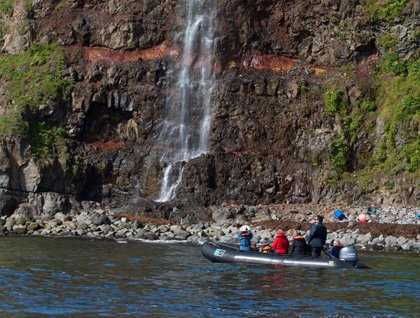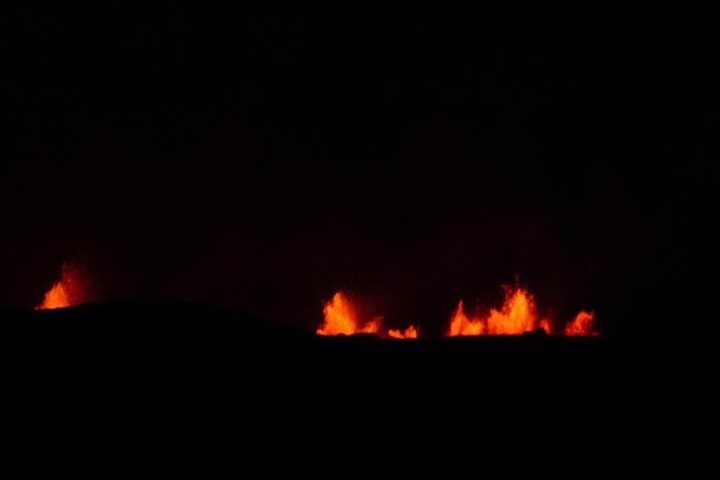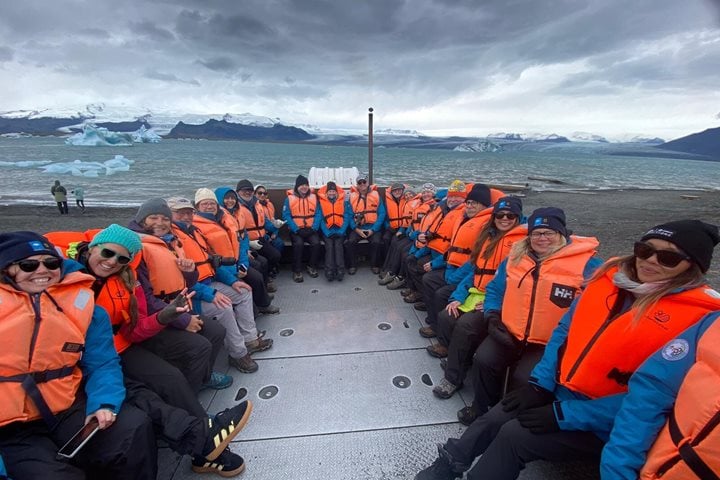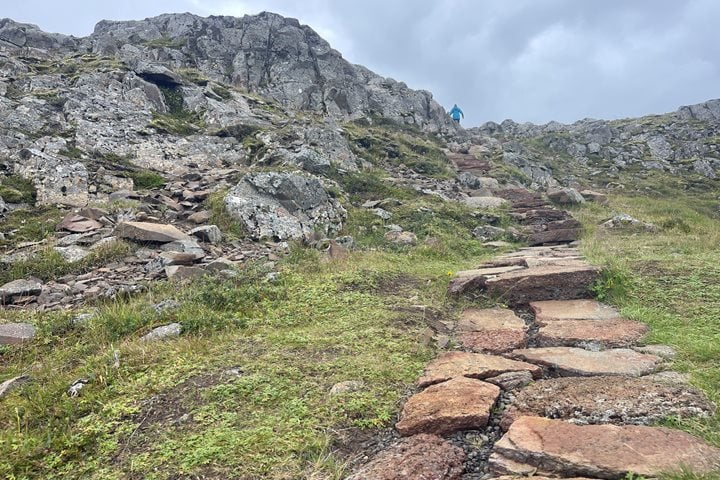The sky is empty and blue.
Our Zodiac skims the surface without a single bounce, slicing the sea like a flying fish, taking us toward the broken wall of rock before us. The water is so unbelievably clear, it’s like gazing through a bottle of Bombay Sapphire.
The gentle sea heaves towards the beach, a pile of smooth stones littered with Siberian driftwood and forgotten fishing buoys. Above us, the stacked layers of black basalt rise up into angular cliffs of brown and grey with stripes of red iron oxide.
“It’s my favorite rock!” says Grace, our naturalist. “I used to collect basalt and crush and smash it up into powder, practically.”
“How did you smash it?” I ask.
“Well, we had hammers and machines and things,” Grace explains, swinging her hands like a Viking with a battleaxe.
“Nobody mess with Grace,” I say, but I am curious as to why such a nice lady would so gleefully smash up rocks.
“What were you looking for?”
“Silica and magnesium. Particles mostly.” Grace is a geologist and frankly, nobody should travel to Iceland without one. All week long she’s dished out the crazy back story behind the most beautiful landscapes in the country.
“See that red there?” she points to an orange ochre stripe at the base of the rock. “That’s tephra from an explosive volcanic eruption.”
Grace tells us that basalt is the most common rock on the sea floor, but then shows us just how uncommon it is. The columnar basalt is less than uniform in this place—instead it looks ropey and cracked.
“As you can see, that’s all chaotically fractured from rapid cooling,” Grace goes on, but I am too lost in the scenery, which is anything but chaotic.
For one, the sky is empty and clear—as blue as the Icelandic flag. The sun is warm and the cliffs are alive, hanging with summer green. Fulmars and phalaropes fly and fall in the air as harlequin and eider ducks dip through the water. A puffin posse paddles past—whimsical but aloof, and on the land, a mother sheep and her lamb are walking the high and grassy ledge.
For a moment, it’s easy to forget that we are just within grasp of the Arctic Circle. The weather is simply too glorious—too warm and sunny and calm today, and nothing like the Langanes I know.
“Long Peninsula” is just that—about thirty miles of land that jut out like a hangnail from Iceland’s northeastern corner. Isolated and inaccessible, it’s a corner of Iceland that few ever see—and while I have been traveling to this country for some 15 years—I have never seen it on a day like today, so unbothered and cheerful.
Icelanders know Langanes as a far-flung shoreline littered with shipwrecks, old and new—each one a tragic testament to the mood of the sea and the wrath of Thor. Fog and snow and wind and waves normally prevent anyone from exploring this coastline as we have done today. Back in the 1950s, the turbulent weather and sheer isolation led to this part of the country being totally abandoned. All we see today are the lowly remains of a ghostly fishing outpost.
An hour later, I’m back on board National Geographic Explorer, enjoying the panorama from the Chart Room, where a guest sips coffee from a mug.
“I was here in 1968,” he utters.
“You were?” I ask. “How? And why?”
Through the window, he points to the rounded top of the highest hill on the peninsula.
“See that? It’s a radar,” he says. Back in the sixties he worked up there, as part of the U.S. military’s efforts to keep watch over the far north Atlantic.
“We were looking for Soviet submarines, but we never saw any come this way.”
I listen carefully to the story—his small collection of memories from this place, carried through the decades of his life until now, when he traveled halfway around the world and sailed with us back to this very point on the globe.
“What’s it like to come back?” I wonder.
“It’s strange,” he replies. “I didn’t see much back then. I remember it was foggy and cold.”
Together we gaze out the window out to the rare landscape before us.
“At first I didn’t think it was there—but then I saw that point up there and recognized it right away—so there it is.” Nothing is hidden today—you can see the entire peninsula with the naked eye.
The ship carries on—down the peninsula and around the point towards the East Fjords. The view from deck is magnificent—the whole of Iceland stands before us, a jagged horizon of snow-kissed mountains and a single silvery line of sunlight painting the surface.
What’s more, it’s still warm . . . and the sky is empty and blue.







